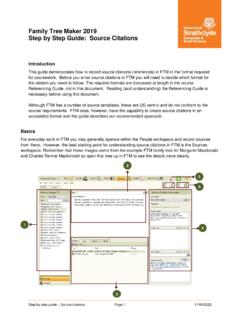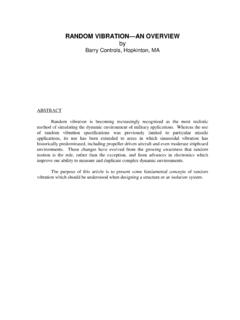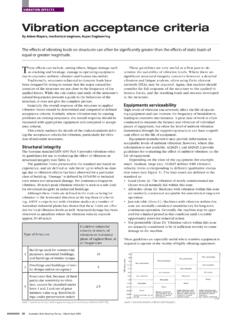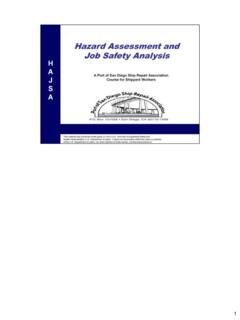Transcription of MODULE DESCRIPTION FORM - strath.ac.uk
1 MODULE DESCRIPTION FORM DEPARTMENT OF MECHANICAL AND AEROSPACE ENGINEERING 16361 (ME305/16318) DYNAMICS AND CONTROL MODULE Registrar: Dr C Maddock Taught To (Course): Cohorts for whom class is compulsory or optional Other Lecturers Involved: Dr O Ganilova Credit Weighting: 20 (ECTS 10) Semester: 1 and 2 Compulsory and optional class Academic Level: 3 Suitable for Exchange: Y Alternative codes and credit values for those taking only one semester: Semester 1: ME305 Dynamics 3 [10 Credits / ECTS 5] Semester 2: 16318 Measurement, Instrumentation and Control [10 Credits / ECTS 5] Required prerequisites Note: It is the responsibility of students to ensure that they satisfy the prerequisite knowledge for this MODULE . If unsure, please contact the MODULE Registrar or discuss with your Programme/Year Adviser of Studies.
2 16232 Engineering Mechanics MM117 Mathematics 1M (or equivalent) ME108 Engineering Analysis and Numerical Methods, ME209 Mathematical Modelling and Analysis (or equivalent) Mathematical methods: Calculus, linear algebra, vectors & matrices. Numerical methods: Solution of linear and nonlinear equations; differentiation and integration; ordinary and partial differential equations Mechanics: Classical mechanics including principles of work, energy, momentum, inertia General plane motion of rigid bodies, kinematics and kinetics of particles Coordinate transforms and frames of reference Simple harmonic motion Programming skills (suggested): Knowledge of basic programming principles: - manipulation of scalar, vectors and matrices variables; - use of operators, expressions and statements (including conditional statements); - structured programming logic and flow diagrams; loops; functions and scripts.
3 Data flow (inputs, outputs) The supported programming development environment is Matlab/Simulink, however it is possible to use other programming environments and languages ( , Python). MODULE Format and Delivery (HOURS 1 credit = 10hrs of study): Lecture Tutorial Laboratory Groupwork External Online Project Assignments Private Study Total 32 31 20 40 77 200 Educational Aim This MODULE aims to: The Semester 1 dynamics course will: 1) Introduce the basics of modelling the vibrations of mechanical systems. 2) Consider the fundamental theory of free and forced vibrations of damped and un-damped systems. 3) Introduce the general principles of modes of vibration. 4) Study transformations from physical to modal space. 5) Consider fundamentals of some energy methods. The Semester 2 control course focuses on modelling the dynamics and analysing the performance of controlled systems, and will: 1) Introduce control theory and its application to engineering systems.
4 2) Study methods to develop mathematical models for the dynamics and control of engineering systems. 3) Introduce control system analysis techniques in order to predict the system performance to given inputs. 4) Show the link between analytical methods and models, and computer models, and explain how to run simulations and analyse the performance of modelled systems. Learning Outcomes On completion of the 1st semester, the student is expected to: LO1 Be able to model and analyse one degree of freedom mass-spring-damper systems. LO2 Be capable of applying the theory of classically damped vibrating systems to problems of one and two degrees of freedom. LO3 Be able to apply and understand the energy methods and principles to predict and analyse the vibration of simple mechanical systems. LO4 Be able to understand and apply the principles of modes of vibration as well as transformation from physical to modal space On completion of the 2nd semester, the student is expected to be able to: LO1 Determine a mathematical model of the dynamics and control of an engineering system in the time and frequency domains.
5 LO2 Determine the system response based on the system model and input. LO3 Analyse the performance of a system. LO4 Appreciate fundamental issues of stability, and apply theory correctly to assess closed-loop system stability. Syllabus The MODULE will teach the following: Dynamics (Semester 1): Mathematical modelling of dynamic system, and system response Free undamped vibration of one degree of freedom systems Free vibrations with viscous friction Forced and transmitted vibrations Applications for single degree of freedom vibration theory Concepts of analysis for two-degree of freedom vibration and modes of vibration Transformations from physical to modal space Application of some energy methods Control (Semester 2): Mathematical modelling (Laplace Transforms, transfer functions, block diagrams, s-plane analysis, general solution for feedback systems) Feedback control system characterisation and performance (errors in closed-loop systems, sensitivity of controllers) Performance of feedback control systems (test input signals, second order systems Stability analysis Assessment of Learning Outcomes For each of the MODULE Learning Outcomes the following criteria will be used to make judgements on student learning: Semester 1 For each of the Learning Outcomes the following learning criteria will apply such that students should be able to: LO1 C1 Model mathematically the dynamics of simple single degree of freedom systems LO2 C2 Derive models for simple 1 DOF vibrating systems.)
6 C3 Derive models for 2 DOF vibrating systems. C4 Analyse the dynamic motion of simple vibrating systems. C5 Understand the principles and the main mechanisms of free damped and un-damped vibration C6 Understand the principles and the main mechanisms of forced vibratory motion and be able to analyse it in terms of dynamic characteristics of appropriate vibrating systems. LO3 C7 Be able to apply some energy methods to the analysis of practical applications of vibrating structures. LO4 C8 Be able to apply the principles of modes of vibration for analysis of dynamic systems. C9 Be able to perform transformation from physical to modal space in some practical applications. Semester 2 For each of the Learning Outcomes the following learning criteria will apply such that students should be able to: LO5 C1 Find a set of linearised differential equations to model the dynamics of appropriate systems.
7 C2 Represent the mathematical model as a block diagram. C3 Use differential equations and block diagrams to determine system transfer functions. LO6 C4 Solve analytically for the output response in the frequency domain of a system based on a specific input function and a mathematical model. C5 Determine the output response of a system in both the time and frequency domains using numerical techniques given a computer model and a specific input. LO7 C6 Determine the poles and zeros of a system. C7 Determine the tracking error and the steady-state error of a system. C8 Design models for dynamic and control responses C9 Design a specific control system and assess its performance LO8 C10 Assess the characteristics of a system response and its stability by constructing and evaluating a Routh-Hurwitz array. C11 Assess the response of a system on the threshold of stability.
8 The standards set for each criterion per MODULE Learning Outcome to achieve a pass grade are indicated on the assessment sheet for all assessment. Principles of Assessment and Feedback (within Assessment and Feedback Policy at: ) Error! Hyperlink reference not valid. Assessment in Semester 1 is performed as One online assessment performed using a quiz with a variety of questions on MyPlace. A coursework based on group work on a set of problems during and outside the tutorials with an individual submission made online on MyPlace. Assessment in Semester 2 is performed as a project based on group work on an applied design problem during and outwith the tutorials, and assessed through an oral presentation. This will assess the application and implementation of concepts and methods learned. A written final exam is used to assess theory and analytical problem solving.
9 Feedback is given in different forms: Self-directed feedback and self-assessment through worked examples and tutorial question sets with answers/solutions Peer assessment in group work during tutorials Informal feedback will be provided through an online forum, through peers and lecturers Tutorials are the primary mechanism for providing regular feedback through discussions and Q&A with lecturers, tutors, and other students, and through self- and peer-assessment of the exercises. Assessment Method(s) Including Percentage Breakdown and Duration of Exams (individual weightings) Examination Coursework Online Assessment Project Number Month(s) Duration Weighting** Number Weighting Number Weighting Number Weighting 1 35% 1 15% 1 Apr/May hrs 40% 1 10% *LO5-8 *LO1-LO4 *LO1-LO2 *LO5-8 * LOs: Indicate which Learning Outcomes (L01, L02, etc) are to be assessed by exam/coursework/practical/project as required.
10 NOTE: For students registered in ME305 or 16318, marks from the relevant assessments (weighted at 50%) will be scaled to 100%. Coursework / Submission deadlines (academic weeks): For Semester 1, an online assessment is performed through the Quiz during Week 5. The coursework should be submitted before the end of Week 11. For Semester 2, a group project will be submitted in Week 9 and assessed by a presentation in Week 10. A written exam will be held during the April/May exam diet. Resit Assessment Procedures: For 16361: 2 hr examination in August diet For 16318 and ME305: 1 hr examination in August diet PLEASE NOTE: Students must gain a summative mark of 40% to pass the MODULE . Students who fail the MODULE at the first attempt will be re-assessed during the August diet. This re-assessment will consist a written exam.














